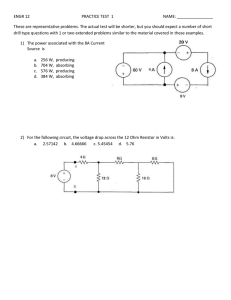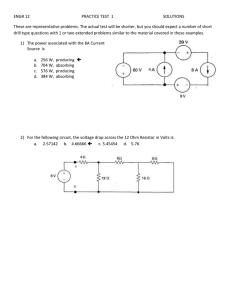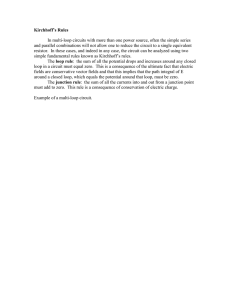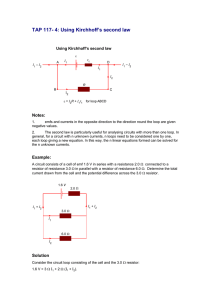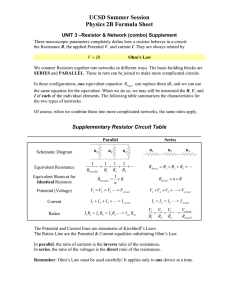Kirchhoff`s Law
advertisement
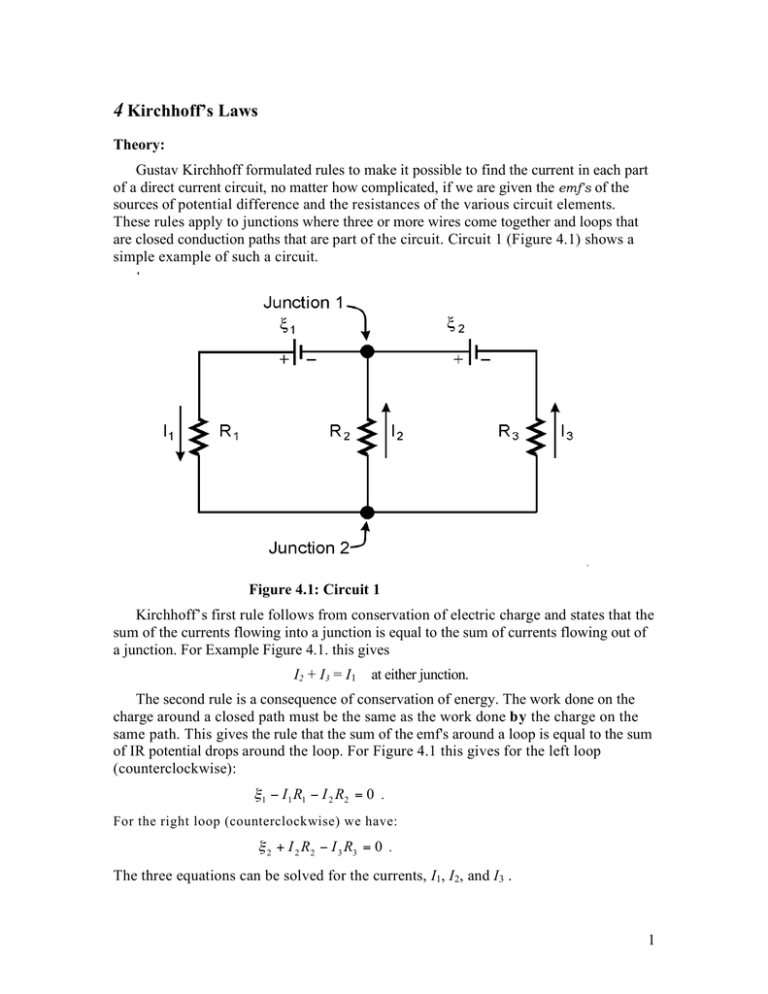
4 Kirchhoff’s Laws Theory: Gustav Kirchhoff formulated rules to make it possible to find the current in each part of a direct current circuit, no matter how complicated, if we are given the emf's of the sources of potential difference and the resistances of the various circuit elements. These rules apply to junctions where three or more wires come together and loops that are closed conduction paths that are part of the circuit. Circuit 1 (Figure 4.1) shows a simple example of such a circuit. Figure 4.1: Circuit 1 Kirchhoff’s first rule follows from conservation of electric charge and states that the sum of the currents flowing into a junction is equal to the sum of currents flowing out of a junction. For Example Figure 4.1. this gives I2 + I 3 = I 1 at either junction. The second rule is a consequence of conservation of energy. The work done on the charge around a closed path must be the same as the work done by the charge on the same path. This gives the rule that the sum of the emf's around a loop is equal to the sum of IR potential drops around the loop. For Figure 4.1 this gives for the left loop (counterclockwise): "1 ! I 1 R1 ! I 2 R2 = 0 . For the right loop (counterclockwise) we have: " 2 + I 2 R2 ! I 3 R3 = 0 . The three equations can be solved for the currents, I1, I2, and I3 . 1 Procedure: A. Resistors in Parallel 1. Select a 2200 ohm and a 1000 ohm resistor and measure the actual resistance with an ohmmeter. Record these two resistor values. 2. Hook up the circuit shown in Figure 4.2 . Use the component values of R1 = 220Ω, R2 = 1000Ω, and the power supply set to 5 volts. 3. Measure the current through each resistor and the voltage drop across each resistor as well as the voltage and current output of the power supply. Figure 4.2: Circuit connected in parallel. 4. Now, using Ohm's Law and Kirchhoff's Laws and the values for voltage and resistance measured above, solve for the current in each leg of the circuit. Make sure to include all equations in the write up showing how the values were obtained. 5. Compare each calculated current with the actual measured current via percent difference calculation. B. Kirchhoff’s Laws applied to a complex circuit 1. Measure the value of each resistor before assembling the circuit shown in Figure 4.3 (below) keeping careful note of which 100 ohm resistor is used where in the circuit. 2. Assemble the circuit using for component values R1 = 100Ω, R 2 = 220Ω, E1 = 10V, and E2 = 5V. 3. Set the power supplies as closely as feasible to the 5V and 10V values. Record the exact values. Measure the voltage drop across each resistor. 4. Using the measured voltage drop across a resistance and measured resistance value of that resistor, calculate the current through each resistor using Ohm's Law. We will call this the experimental or measured current. 2 5. Using Kirchhoff’s Laws and the actual measured values of the resistors and potential sources, set up the necessary simultaneous equations and calculate the theoretical currents through each resistor. Specifically show the I directions chosen, the loop directions and all steps in this calculation in your Results. 6. Tabulate both "measured” (from step 4) and "calculated” (from step 5) currents in the table below and compare them with one another via percent difference calculation. Figure 4.3: Complex Circuit. Part A. Parallel Resistors i 1. R i (ohms) Vi (volts) Ii exp(amps) (amps) Ii theo (amps) % Difference 2. Req 3 Part B. Complex circuit and Kirchhoff's laws i Ri (ohms) Vi (volts) Ii exp (amps) Ii theo (amps) % Difference 1. 2. 3. 4. 4

